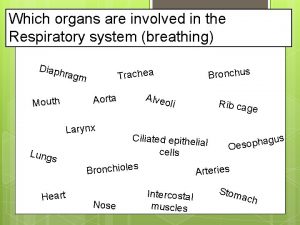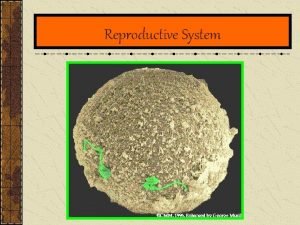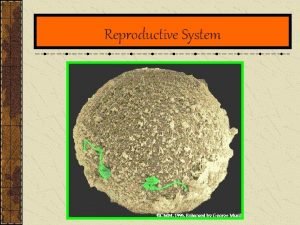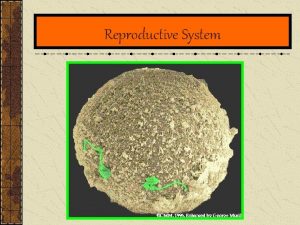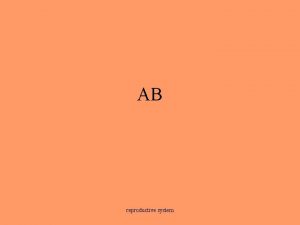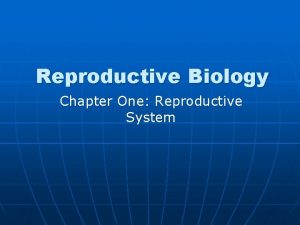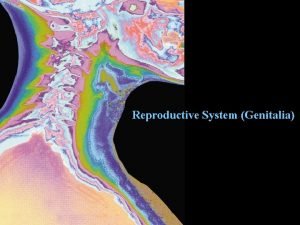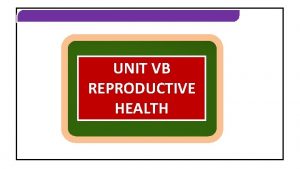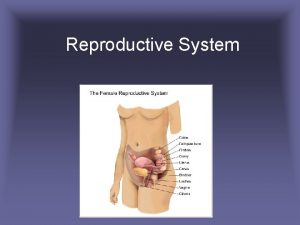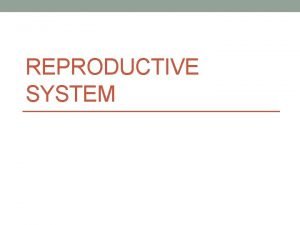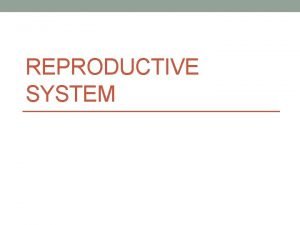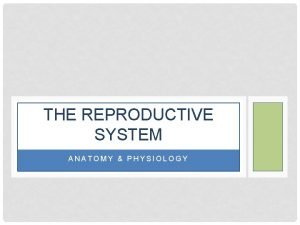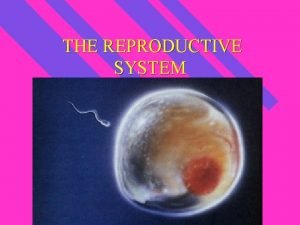The Reproductive System only system not directly involved








































- Slides: 40

The Reproductive System – only system not directly involved in homeostasis § Gonads — primary sex organs § Testes in males § Ovaries in females § Gonads produce gametes (sex cells), secrete hormones § Sperm — male gametes § Ova (eggs) — female gametes

Male Reproductive System Overview § Testes – sperm makers § Duct system All but urethra are paired (you probably knew that) § Epididymis – sperm mature and stored here § Ductus (vas) deferens – help propel sperm (peristalsis) to urethra during ejaculation § Urethra – last bit of tubing, sperm and urine kept separate

Testes § Tunica albuginea — fibrous capsule around each teste §seminiferous tubules – coiled spermatogenesis (sperm making) tubes § 400 ft per teste!! §Androgens (like testosterone) also produced inside (by unique cells) Where are the little guys stored again?

Male Reproductive System: Accessory organs § Seminal vesicles – paired glands at end of vas deferens Responsible for 60 -70% of semen Secretions include sugar, vitamin C, hormones Nourishes sperm, stimulates uterine contractions 40, 000 men die/yr from prostate cancer! § Prostate – surrounds urethra, secretes sperm activating fluid § Bulbourethral glands – secrete lubricant, cleanse urethra of urine Paired like vesicles Figure 16. 2 a

External Male Genitalia = penis and scrotum § Scrotum = sac of skin, keeps testes 3°C cooler for healthy sperm § Penis = organ of copulation, capillaries fill with blood = erection

Participating… seminiferous § Sperm are first generated in the _______ epididymus tubules. They migrate to the _______ where they mature and are stored. Sperm travel vas or ductus _____ deferens through the ______ during urethra ejaculation and exit via the ______.

Spermatogenesis = production of sperm cells § Begins at puberty (increased FSH + LH production), continues through life § Spermatocytes undergo meiosis to form 4 spermatids = immature sperm § Sperm are haploid (1 set of chromosomes = 23 in humans)

From primary spermatocyte to mature sperm takes 64 -72 days…each mature sperm looks like this: Head – contains DNA, anterior acrosome helps digest layer around egg Midpiece – base of flagella, mitochondria for ATP Tail – whip-like flagella, these things can swim don’t you know… Only human cell with one of these! Figure 16. 5 b

Semen has sperm (150 – 350 million per event) and… § Fructose for sperm energy § Alkalinity (p. H=7. 2 -7. 6) to neutralize acidic (p. H 3. 5 - 4) vaginal mucosa § Antibiotics and hormones § Elements to enhance sperm motility

Hormones Control male sexual development Begins during puberty… § Reproductive organ development § Sex drive § Secondary characteristics § Deepening voice § Increased hair growth § Enlargement of skeletal muscles § Thickening of bones Figure 16. 6

Why are gametes (sperm and eggs) haploid? Otherwise, too many chromosomes to start with… § Sperm (23 chromosomes) unites with egg (23) to create zygote (2 n = 46)

Participating… § Sperm are the only cells of the human body that flagella For every spermatocyte, ______ 4 have _______. mature sperm may form. Each sperm is haploid so that fertilization results in a diploid _____ Semen includes sperm and glandular zygote. _______ secretions that nourish and activate the sperm.

Female Reproductive System § § § Ovaries – produce egg-making cells Uterine (Fallopian) tubes – collect egg-making cells, site of fertilization Uterus – receives, retains, and nourishes fertilized egg Vagina – organ of copulation, birth canal External genitalia

Ovaries house many follicles (sacs) that hold oocytes (egg-making cells) § As oocyte matures, follicles get bigger § Ovulation = follicle ruptures, releases mature oocyte § Occurs every ≈28 days § Oocyte captured (usually) by uterine tubes…

Uterine (fallopian) tubes do not directly connect to ovaries… § Fimbriae = finger-like projections of uterine tube, catch oocyte § Some oocytes lost, degenerate in abdominal cavity § Cilia line uterine tube, move oocyte toward uterus (3 -4 days) § Oocyte lives only 24 hours, so fertilization occurs in uterine tube Figure 16. 8 b

Uterus = hollow organ that receives, retains, and nourishes fertilized egg § Located between bladder and rectum § Cervix — narrow outlet of uterus; must dilate during childbirth

§ Endometrium – inner layer where implantation (attachment) of fertilized egg occurs § Sloughs off if no pregnancy occurs (menses) § Myometrium — middle layer of smooth muscle = childbirth, sperm propulsion § Perimetrium (visceral peritoneum)—outermost serous layer Uterus wall has 3 layers: Figure 16. 8 b

Participating… ovaries and § Oocytes are released by the ____ fimbriae of the uterine tubes. captured by the _____ cilia The oocyte is then moved with ____ toward uterus the _____ where implantation occurs.

External Female Genitalia (Vulva) § Mons pubis – fat layer over pubis § Labia – 2 pairs of skin folds § Clitoris – homologue to penis, sensitive erectile tissue § Urethral orifice § Vaginal orifice § Greater vestibular glands – secrete lubricating fluid

Oogenesis and the Ovarian Cycle § All eggs partially formed at birth § Egg release begins at puberty, ends at menopause § Follicle stimulating hormone (FSH) causes follicles to mature each month § Ovulation (release of 2° oocyte) stimulated by Luteinizing Hormone (LH)

Oogenesis: only 1 functional ovum (egg) comes from each oocyte Meiotic Events Before birth The ovum provides zygote (1 st diploid cell) with nutrients and cytoplasm (all your mitochondria came from Ma! – thanks, Ma!) Follicle Development in Ovary 2 n Oogonium (stem cell) 2 n Primary oocyte Mitosis Primary follicle Growth 2 n Primary oocyte (arrested in prophase I; present at birth) Primary follicle 2 n Meiosis I (completed by one primary oocyte each month) First polar body Primary oocyte (still arrested in prophase I) Growing follicle Secondary oocyte (arrested in metaphase II) Ovulation n Sperm Meiosis II of polar body (may or may not occur) n Polar bodies (all polar bodies degenerate) Primary follicle (ovary inactive) Childhood Each month from puberty to menopause How many sperm from spermatocytes? Follicle cells Oocyte n n n Second polar body Meiosis II completed (only if sperm penetration occurs) Mature vesicular (Graafian) follicle Ovulated secondary oocyte Ovum Figure 16. 10

Meiosis of oocytes does not finish unless fertilized by sperm! § If sperm reaches oocyte, oocyte finishes meiosis = ovum (egg) § sperm nucleus fuses with egg nucleus = zygote § If oocyte does not meet sperm, it dies w/out completing meiosis

Male and Female Differences § Males — 4 sperm per spermatocyte § Females — 1 ovum (3 polar bodies) per oocyte § Sex cell size and structure § Sperm = tiny, motile § Egg = large, non-motile, and has nutrients to nourish embryo until implantation

Uterine (Menstrual) Cycle = cyclic changes of endometrium § Regulated by estrogens and progesterone § FSH and LH regulate estrogens and progesterone § Both hormonal cycles ≈28 days in length

Uterine (Menstrual) Cycle has 3 stages… § Menstrual phase – day 1 -5, endometrium breaks down (= 3 -5 days of bleeding) § Proliferative stage – day 6 -14, endometrium rebuilt, estrogen levels rise, ovulation on day 14 § Secretory stage – day 15 -28, progesterone rises, endometrium prepares for implantation § If no implantation, back to menstrual phase § If implantation occurs, endometrium maintained by hormones

Hormone Production by the Ovaries § Estrogens – produced by follicle cells § Cause secondary sex characteristics § Development of breasts and pubic hair § Widening and lightening of the pelvis § Onset of menses (menstrual cycle) § Progesterone – produced by corpus luteum § Helps maintain pregnancy § Prepare breasts for milk production

Participating… § The uterine (menstrual) cycle is controlled by the estrogen(s) and ______ progesterone that are hormones _____ in turn controlled by _____ Bleeding FSH and ______. LH occurs because of the breakdown of the endometrium if the egg is not ______. fertilized _______

Mammary Glands § Modified sweat glands § Function is to produce milk in females § Stimulated by sex hormones (mostly estrogens) to increase in size Breast cancer kills 40, 000 American women each year! Self exams monthly; mammograms every 2 years after 40; every year after 50

First few days we don’t look too human… Inner cell mass Blastocyst cavity Trophoblast (a) Zygote (fertilized egg) (b) Early cleavage 4 -cell stage Fertilization (c) Morula (d) Early blastocyst (a) (b) (e) Late blastocyst (implanting) (c) Ovary (d) Uterine tube (e) Secondary oocyte Ovulation Uterus Endometrium Figure 16. 15, step 6

The embryo develops over an 8 week period Success depends on… 1. Cell determination - skin, nerve, muscle is your fate 2. Cell differentiation - cells realize their fate 3. Morphogenesis - cells take their appropriate positions Fig. 17. 5 b, p. 318

Apoptosis (programmed cell death) aids morphogenesis Responsible for finger and toe formation, for example. Fig. 17. 7 a, p. 319

Embryo becomes a fetus at about 8 weeks Obviously human, but only 1 inch tall Week 4 Week 5 -6 Week 8

Development of the fetus • Heartbeat and sex detectable by end of 1 st trimester (1 -3 months) • Large movements and sucking reflex occur by the end of the 2 nd trimester (4 -6 months) • Organ systems mature in 3 rd trimester • Mature enough to survive by middle of 8 th month • 95% chance of survival by month 9

Fetal Circulatory System Before birth, temporary vessels limit blood to liver and lungs = fetal circulatory system. Why? These gradually close by age 1. Fig. 17. 13 a, p. 325

Participate § When is the final exam? Monday, June 7, 8 – 10: 30 am § What should you bring with you to the exam? Pencil and scantron (F-288, same as usual) § Are you going to study – even just a little? Yes, of course.

Development of the Human Fetus Table 16. 1 (1 of 2)

Development of the Human Fetus Table 16. 1 (2 of 2)

Photographs of a Developing Fetus Figure 16. 18 a

Photographs of a Developing Fetus Figure 16. 18 b

Ovulation Figure 16. 11
 Author tone definition
Author tone definition Not genuine, not true, not valid
Not genuine, not true, not valid Female reproductive system labeled
Female reproductive system labeled Endocrine system and reproductive system
Endocrine system and reproductive system Take only photos leave only footprints
Take only photos leave only footprints Which organs are involved in respiratory system
Which organs are involved in respiratory system Hát kết hợp bộ gõ cơ thể
Hát kết hợp bộ gõ cơ thể Lp html
Lp html Bổ thể
Bổ thể Tỉ lệ cơ thể trẻ em
Tỉ lệ cơ thể trẻ em Gấu đi như thế nào
Gấu đi như thế nào Thang điểm glasgow
Thang điểm glasgow Alleluia hat len nguoi oi
Alleluia hat len nguoi oi Môn thể thao bắt đầu bằng chữ đua
Môn thể thao bắt đầu bằng chữ đua Thế nào là hệ số cao nhất
Thế nào là hệ số cao nhất Các châu lục và đại dương trên thế giới
Các châu lục và đại dương trên thế giới Cong thức tính động năng
Cong thức tính động năng Trời xanh đây là của chúng ta thể thơ
Trời xanh đây là của chúng ta thể thơ Cách giải mật thư tọa độ
Cách giải mật thư tọa độ Làm thế nào để 102-1=99
Làm thế nào để 102-1=99 độ dài liên kết
độ dài liên kết Các châu lục và đại dương trên thế giới
Các châu lục và đại dương trên thế giới Thơ thất ngôn tứ tuyệt đường luật
Thơ thất ngôn tứ tuyệt đường luật Quá trình desamine hóa có thể tạo ra
Quá trình desamine hóa có thể tạo ra Một số thể thơ truyền thống
Một số thể thơ truyền thống Cái miệng nó xinh thế
Cái miệng nó xinh thế Vẽ hình chiếu vuông góc của vật thể sau
Vẽ hình chiếu vuông góc của vật thể sau Biện pháp chống mỏi cơ
Biện pháp chống mỏi cơ đặc điểm cơ thể của người tối cổ
đặc điểm cơ thể của người tối cổ Ví dụ về giọng cùng tên
Ví dụ về giọng cùng tên Vẽ hình chiếu đứng bằng cạnh của vật thể
Vẽ hình chiếu đứng bằng cạnh của vật thể Tia chieu sa te
Tia chieu sa te Thẻ vin
Thẻ vin đại từ thay thế
đại từ thay thế điện thế nghỉ
điện thế nghỉ Tư thế ngồi viết
Tư thế ngồi viết Diễn thế sinh thái là
Diễn thế sinh thái là Dot
Dot Số.nguyên tố
Số.nguyên tố Tư thế ngồi viết
Tư thế ngồi viết Lời thề hippocrates
Lời thề hippocrates





